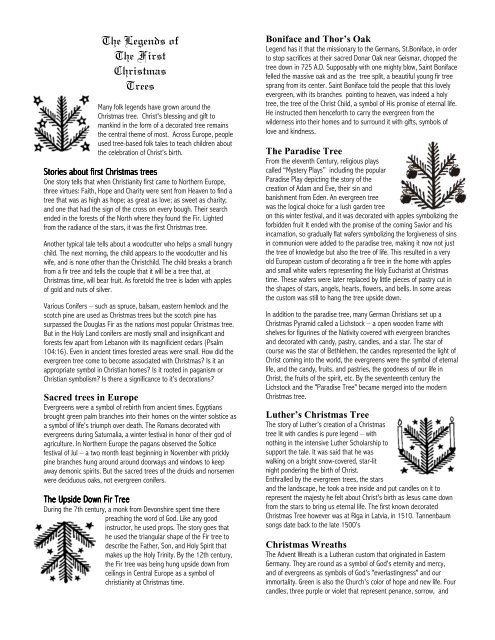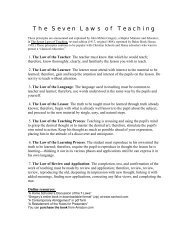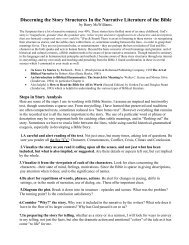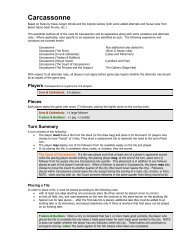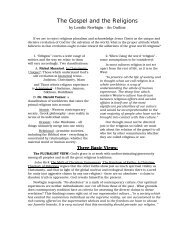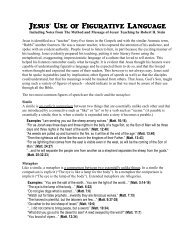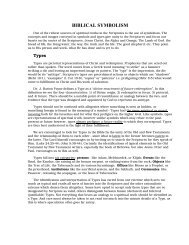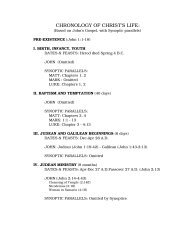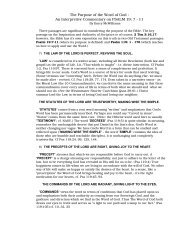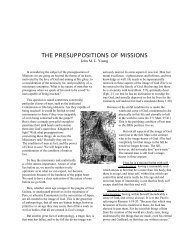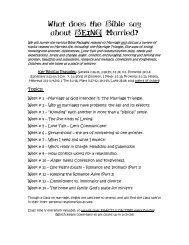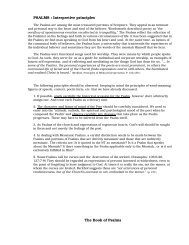The Legends of The First Christmas Trees - Eldrbarry's Story Telling ...
The Legends of The First Christmas Trees - Eldrbarry's Story Telling ...
The Legends of The First Christmas Trees - Eldrbarry's Story Telling ...
Create successful ePaper yourself
Turn your PDF publications into a flip-book with our unique Google optimized e-Paper software.
<strong>The</strong> <strong>Legends</strong> <strong>of</strong><br />
<strong>The</strong> <strong>First</strong><br />
<strong>Christmas</strong><br />
<strong>Trees</strong><br />
Many folk legends have grown around the<br />
<strong>Christmas</strong> tree. Christ's blessing and gift to<br />
mankind in the form <strong>of</strong> a decorated tree remains<br />
the central theme <strong>of</strong> most. Across Europe, people<br />
used tree-based folk tales to teach children about<br />
the celebration <strong>of</strong> Christ's birth.<br />
Stories about first <strong>Christmas</strong> trees<br />
One story tells that when Christianity first came to Northern Europe,<br />
three virtues: Faith, Hope and Charity were sent from Heaven to find a<br />
tree that was as high as hope; as great as love; as sweet as charity;<br />
and one that had the sign <strong>of</strong> the cross on every bough. <strong>The</strong>ir search<br />
ended in the forests <strong>of</strong> the North where they found the Fir. Lighted<br />
from the radiance <strong>of</strong> the stars, it was the first <strong>Christmas</strong> tree.<br />
Another typical tale tells about a woodcutter who helps a small hungry<br />
child. <strong>The</strong> next morning, the child appears to the woodcutter and his<br />
wife, and is none other than the Christchild. <strong>The</strong> child breaks a branch<br />
from a fir tree and tells the couple that it will be a tree that, at<br />
<strong>Christmas</strong> time, will bear fruit. As foretold the tree is laden with apples<br />
<strong>of</strong> gold and nuts <strong>of</strong> silver.<br />
Various Conifers – such as spruce, balsam, eastern hemlock and the<br />
scotch pine are used as <strong>Christmas</strong> trees but the scotch pine has<br />
surpassed the Douglas Fir as the nations most popular <strong>Christmas</strong> tree.<br />
But in the Holy Land conifers are mostly small and insignificant and<br />
forests few apart from Lebanon with its magnificient cedars (Psalm<br />
104:16). Even in ancient times forested areas were small. How did the<br />
evergreen tree come to become associated with <strong>Christmas</strong>? Is it an<br />
appropriate symbol in Christian homes? Is it rooted in paganism or<br />
Christian symbolism? Is there a significance to it’s decorations?<br />
Sacred trees in Europe<br />
Evergreens were a symbol <strong>of</strong> rebirth from ancient times. Egyptians<br />
brought green palm branches into their homes on the winter solstice as<br />
a symbol <strong>of</strong> life's triumph over death. <strong>The</strong> Romans decorated with<br />
evergreens during Saturnalia, a winter festival in honor <strong>of</strong> their god <strong>of</strong><br />
agriculture. In Northern Europe the pagans observed the Soltice<br />
festival <strong>of</strong> Jul – a two month feast beginning in November with prickly<br />
pine branches hung around around doorways and windows to keep<br />
away demonic spirits. But the sacred trees <strong>of</strong> the druids and norsemen<br />
were deciduous oaks, not evergreen conifers.<br />
<strong>The</strong> Upside Down Fir Tree<br />
During the 7th century, a monk from Devonshire spent time there<br />
preaching the word <strong>of</strong> God. Like any good<br />
instructor, he used props. <strong>The</strong> story goes that<br />
he used the triangular shape <strong>of</strong> the Fir tree to<br />
describe the Father, Son, and Holy Spirit that<br />
makes up the Holy Trinity. By the 12th century,<br />
the Fir tree was being hung upside down from<br />
ceilings in Central Europe as a symbol <strong>of</strong><br />
christianity at <strong>Christmas</strong> time.<br />
Boniface and Thor’s Oak<br />
Legend has it that the missionary to the Germans, St.Boniface, in order<br />
to stop sacrifices at their sacred Donar Oak near Geismar, chopped the<br />
tree down in 725 A.D. Supposably with one mighty blow, Saint Boniface<br />
felled the massive oak and as the tree split, a beautiful young fir tree<br />
sprang from its center. Saint Boniface told the people that this lovely<br />
evergreen, with its branches pointing to heaven, was indeed a holy<br />
tree, the tree <strong>of</strong> the Christ Child, a symbol <strong>of</strong> His promise <strong>of</strong> eternal life.<br />
He instructed them henceforth to carry the evergreen from the<br />
wilderness into their homes and to surround it with gifts, symbols <strong>of</strong><br />
love and kindness.<br />
<strong>The</strong> Paradise Tree<br />
From the eleventh Century, religious plays<br />
called “Mystery Plays” including the popular<br />
Paradise Play depicting the story <strong>of</strong> the<br />
creation <strong>of</strong> Adam and Eve, their sin and<br />
banishment from Eden. An evergreen tree<br />
was the logical choice for a lush garden tree<br />
on this winter festival, and it was decorated with apples symbolizing the<br />
forbidden fruit It ended with the promise <strong>of</strong> the coming Savior and his<br />
incarnation, so gradually flat wafers symbolizing the forgiveness <strong>of</strong> sins<br />
in communion were added to the paradise tree, making it now not just<br />
the tree <strong>of</strong> knowledge but also the tree <strong>of</strong> life. This resulted in a very<br />
old European custom <strong>of</strong> decorating a fir tree in the home with apples<br />
and small white wafers representing the Holy Eucharist at <strong>Christmas</strong><br />
time. <strong>The</strong>se wafers were later replaced by little pieces <strong>of</strong> pastry cut in<br />
the shapes <strong>of</strong> stars, angels, hearts, flowers, and bells. In some areas<br />
the custom was still to hang the tree upside down.<br />
In addition to the paradise tree, many German Christians set up a<br />
<strong>Christmas</strong> Pyramid called a Lichstock – a open wooden frame with<br />
shelves for figurines <strong>of</strong> the Nativity covered with evergreen branches<br />
and decorated with candy, pastry, candles, and a star. <strong>The</strong> star <strong>of</strong><br />
course was the star <strong>of</strong> Bethlehem, the candles represented the light <strong>of</strong><br />
Christ coming into the world, the evergreens were the symbol <strong>of</strong> eternal<br />
life, and the candy, fruits, and pastries, the goodness <strong>of</strong> our life in<br />
Christ, the fruits <strong>of</strong> the spirit, etc. By the seventeenth century the<br />
Lichstock and the "Paradise Tree" became merged into the modern<br />
<strong>Christmas</strong> tree.<br />
Luther’s <strong>Christmas</strong> Tree<br />
<strong>The</strong> story <strong>of</strong> Luther’s creation <strong>of</strong> a <strong>Christmas</strong><br />
tree lit with candles is pure legend – with<br />
nothing in the intensive Luther Scholarship to<br />
support the tale. It was said that he was<br />
walking on a bright snow-covered, star-lit<br />
night pondering the birth <strong>of</strong> Christ.<br />
Enthralled by the evergreen trees, the stars<br />
and the landscape, he took a tree inside and put candles on it to<br />
represent the majesty he felt about Christ's birth as Jesus came down<br />
from the stars to bring us eternal life. <strong>The</strong> first known decorated<br />
<strong>Christmas</strong> Tree however was at Riga in Latvia, in 1510. Tannenbaum<br />
songs date back to the late 1500’s<br />
<strong>Christmas</strong> Wreaths<br />
<strong>The</strong> Advent Wreath is a Lutheran custom that originated in Eastern<br />
Germany. <strong>The</strong>y are round as a symbol <strong>of</strong> God's eternity and mercy,<br />
and <strong>of</strong> evergreens as symbols <strong>of</strong> God's "everlastingness" and our<br />
immortality. Green is also the Church's color <strong>of</strong> hope and new life. Four<br />
candles, three purple or violet that represent penance, sorrow, and
longing expectation and one rose or pink that represents the hope and<br />
coming joy are placed within to represent the four weeks <strong>of</strong> Advent.<br />
Wreaths are an ancient symbol <strong>of</strong> victory and symbolize the "fulfillment<br />
<strong>of</strong> time" in the coming <strong>of</strong> Christ and the glory <strong>of</strong> His birth.<br />
<strong>The</strong> <strong>Christmas</strong> Market <strong>Trees</strong><br />
By the early 1600's many German towns were celebrating <strong>Christmas</strong><br />
with elaborately decorated trees. <strong>Christmas</strong> markets were set up to<br />
provide everything from gifts, food and more practical things such as a<br />
knife grinder to sharpen the knife to carve the <strong>Christmas</strong> Goose!<br />
Gingerbreads and wax ornaments bought as souvenirs were taken<br />
home to hang on <strong>Christmas</strong> <strong>Trees</strong>. A visitor to<br />
Strasbourg in 1601 records a tree decorated with<br />
"wafers and golden sugar-twists (Barleysugar) and<br />
paper flowers <strong>of</strong> all colours". <strong>The</strong> early trees were<br />
biblically symbolic <strong>of</strong> the Paradise Tree in the<br />
Garden <strong>of</strong> Eden. Decorations first used were paper<br />
flowers, fruits, nuts, gold foil, cakes, small gifts, and candies. So<br />
popular had this custom become that by the end <strong>of</strong> the sixteenth<br />
century many communities in Alsace limited or prohibited the use <strong>of</strong><br />
evergreens for the holidays, in part, to protect the forests from the<br />
over-cutting <strong>of</strong> young trees. <strong>Christmas</strong> trees continued to grow in<br />
popularity during the seventeenth and eighteenth centuries particularly<br />
among Lutherans and they brought the custom to England and the<br />
Americas.<br />
Modern <strong>Christmas</strong> <strong>Trees</strong><br />
<strong>Christmas</strong> trees became fashionable in the mid 1800’s. In 1846, the<br />
popular Royals, Queen Victoria and her German Prince, Albert, were<br />
illustrated in the London News with their children around a <strong>Christmas</strong><br />
Tree. In America, the White House led the way to trees for the holidays<br />
beginning with President Franklin Pierce Despite some congregation’s<br />
concerns about bringing trees into their religious traditions, trees<br />
quickly were adopted as symbols <strong>of</strong> Christ’s Advent.<br />
Special <strong>Trees</strong> in the Bible<br />
<strong>Trees</strong> are not especially significant as symbols in the Bible, though<br />
used as metaphors (Psalm 1:3, Prov 11:30; Psalm 104:16, Dan 4).<br />
Several trees, however, are key symbols: <strong>The</strong> Tree <strong>of</strong> Knowing Good<br />
and Evil in the garden <strong>of</strong> Eden symbolizes the temptation and fall <strong>of</strong><br />
man (Genesis 3) – it was a fruit free obviously.<br />
Mankind sinned by eating its fruit, though<br />
commanded not to by God.<br />
<strong>The</strong> Tree <strong>of</strong> Life appears at both the beginning<br />
and end <strong>of</strong> the Bible. Genesis 2:9; 3:22 and Rev<br />
22:2. <strong>The</strong> Branch is one <strong>of</strong> the titles given to<br />
the Messiah in Isa 4:2, 11:1, Jer 23:5, Zech 3:8,<br />
6:12. <strong>The</strong> Cross is spoken <strong>of</strong> as a tree in Gal 3:13 and 1 Peter 2:24 . It<br />
is the most significant “tree” in the Bible – a symbol representing the<br />
Savior’s giving himself as the sacrifice for the sins <strong>of</strong> men.<br />
<strong>Christmas</strong> <strong>Trees</strong> are neither significant pagan nor biblical symbols. But<br />
various Christian traditions have evolved that use the evergreen and its<br />
decorations to symbolize and teach the wonderful truths <strong>of</strong> Advent –<br />
God sending His Son to bring eternal life to a fallen world. Though<br />
abused by popular culture, <strong>Christmas</strong> <strong>Trees</strong> may still point to that true<br />
Light <strong>of</strong> the World.<br />
<strong>The</strong> <strong>Legends</strong><br />
<strong>of</strong><br />
<strong>The</strong> <strong>First</strong><br />
<strong>Christmas</strong><br />
<strong>Trees</strong><br />
Told by Eldrbarry<br />
<strong>Christmas</strong> 2001 ---- Barry McWilliams (eldrbarry)<br />
Chapel Hill Presbyterian Church, Lake Stevens, Wa
Germany's Tannenbaum (<strong>Christmas</strong> Tree)<br />
<strong>The</strong> German religious reformer Martin<br />
Luther (1483-1546) is <strong>of</strong>ten credited with<br />
starting the <strong>Christmas</strong> tree custom,<br />
but the first appearance <strong>of</strong> a Tannenbaum was recorded in<br />
Germany many years after Luther's death. It was in 1605<br />
in Strasbourg in Alsace, then in Germany, that a chronicler<br />
wrote (in old German): "Auff Weihenachten richtett man<br />
Dahnnenbäum zu Strasburg in den Stuben<br />
auff..." ("At <strong>Christmas</strong> they set up <strong>Christmas</strong><br />
trees in their rooms...").<br />
But it is likely that the custom dates back to<br />
at least around 1550, since the first <strong>of</strong><br />
several "Tannenbaum" ballads was<br />
circulating in print at that time. By the 19th century<br />
this custom had spread across most <strong>of</strong><br />
Germany and beyond. Several royal Germans<br />
are credited with helping extend the tree<br />
decorating custom beyond Germany's<br />
borders. <strong>The</strong> Duchess <strong>of</strong> Orleans (from<br />
Mecklenburg) brought it to Paris, while other<br />
Germanic royals brought the <strong>Christmas</strong> tree<br />
to England and other European countries.<br />
But it was commoners–emigrants from<br />
Germany–who brought the Weihnachtsbaum to<br />
<strong>The</strong> Austrians, Germans, and Swiss are<br />
slowly using more "electric candles" for tree<br />
decoration, but many a Germanic Christbaum<br />
continues to glow with the warm light<br />
<strong>of</strong> real wax candles. (Germans use special<br />
candle holders and have learned how to do<br />
this safely; the candles are not left to burn for a long time or<br />
without someone in the room.)<br />
<strong>The</strong> use <strong>of</strong> evergreens as a <strong>Christmas</strong> symbol <strong>of</strong> everlasting<br />
life goes back much further than even 1550s, but still<br />
with a Germanic connection. St. Boniface is said to have<br />
introduced the use <strong>of</strong> evergreens in connection with his<br />
efforts to Christianize the Germanic tribes in the 8th century.<br />
He dedicated the fir tree (Tannenbaum) to the Christ<br />
Child, displacing the pagan oak tree <strong>of</strong> Odin.<br />
A more recent "old" Bavarian tradition is the so-called "Bride's<br />
Tree," upon which a dozen special ornaments are hung<br />
to help ensure a better life for a married couple. <strong>The</strong> 12<br />
ornaments and their symbolic significance are: angel (God's<br />
guidance), bird (joy), fish (Christ's blessing), flower basket<br />
(good wishes), fruit basket (generosity), heart (true love),<br />
house (protection), pine cone (fruitfulness), rabbit (hope),<br />
rose (affection), Santa (goodwill), and teapot<br />
(hospitality). Special hand-blown glass ornaments in these<br />
forms are still produced in Bavaria.<br />
America.<br />
Links.<br />
For more about the <strong>Christmas</strong> tree, see our <strong>Christmas</strong> Tree


